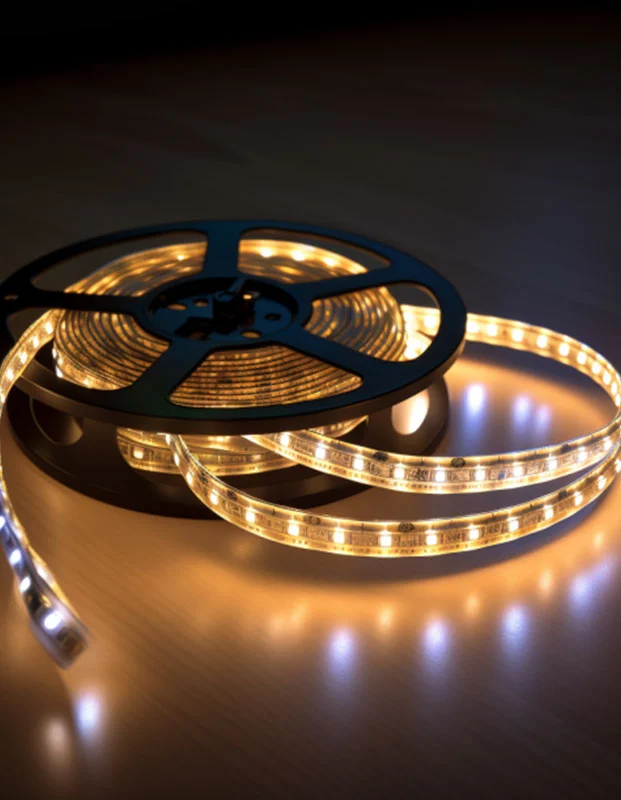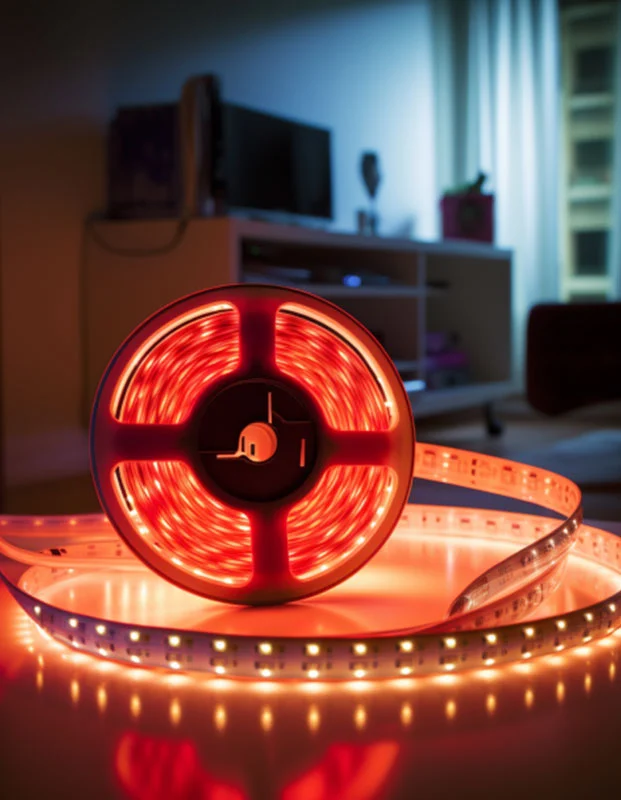LED strip lighting can be used in indoor or outdoor decoration if you install led strip lights in living room, when you feel tired, then want to take some rest or feel more romantic, we strongly advise you to have some led strip lights, for example, 220v smd led strip, for living room ceiling, don't hesitate.

The standard for feeling comfortable and relaxing in living room-led strip lighting is to install a warm white color, which looks like a little yellow light.

When buying indoor LED strip lights, there are several factors to consider to ensure you make the right led light selection. Here are some key points to look out for:
Brightness and Light Output: Consider the brightness level you desire for your indoor space. Look for the lumen rating or the number of LEDs per meter. Higher lumens or more LEDs per meter generally indicate brighter light output.
Color Temperature: Indoor LED strips come in various color temperatures, ranging from warm white (soft and cozy) to cool white (crisp and bright). Determine the ambiance you want to create and choose the appropriate color temperature.
Color Options: Some luminar indoor LED tape lights offer a wide range of colors and even color-changing led lights for room options. If you prefer versatile lighting options, look for RGB (Red, Green, Blue) or RGBW (Red, Green, Blue, White) indoor LED tape lights that allow you to change colors and create different lighting effects.
Length and Flexibility: Consider the length of the luminar indoor led tape light you need for your indoor space. Check if the strip can be easily cut to the desired length without damaging it. Also, consider the flexibility of the strip to ensure it can be bent or curved to fit your specific requirements.
Adhesive Backing: Look for LED strips that come with adhesive backing for easy installation. Ensure the adhesive is strong and reliable to prevent the strip from falling off over time.
Dimmability and Controls: If you want to control the brightness or color of the indoor strip led lights, check if they are dimmable and compatible with the appropriate controllers. Some LED strips may require additional equipment to control their settings.
Energy Efficiency: LED lights are known for their energy efficiency. Look for LED strip lights that are labeled as energy-efficient or have a high energy-efficiency rating. This will help you save on electricity bills in the long run.
Quality and Durability: Consider the build quality of the LED strip lights. Look for strips made from high-quality materials that are resistant to moisture, dust, and heat. Additionally, check if they have good heat dissipation capabilities to prevent overheating.

LED tape lights, also known as LED ribbon lights or indoor LED tape lights, are a type of flexible LED light solution. They consist of a thin, flexible circuit board with embedded LED chips and an adhesive backing. Here are some key features of luminar indoor LED tape light:
Flexibility: LED luminar indoor tape lights are highly flexible and can be bent, curved, or shaped to fit various contours, making them suitable for installations in tight or curved spaces.
Size and Design: They are typically thinner and narrower than LED indoor strip lights, which makes them more discreet and ideal for applications where a low-profile lighting solution is desired.
Adhesive Backing: luminar indoor LED tape lights usually come with an adhesive backing that allows for easy installation on various surfaces, including walls, ceilings, and furniture.
Light Dispersal: Due to their design, luminar indoor tape lights often provide more diffuse and uniform lighting, which can be suitable for creating soft ambient illumination.
Applications: LED tape lights are commonly used for under-cabinet lighting, cove lighting, accent lighting, and decorative lighting in residential and commercial settings.
Interior strip lightings are also flexible lighting solutions but come in a wider format compared to tape lights. They consist of a longer circuit board with multiple LED chips. Here are the key features of LED strip lights:
Brightness and Coverage: LED indoor strip lighting is available in various densities and can provide more intense illumination compared to tape lights. They are often used for applications where stronger lighting is required.
Mounting Options: While indoor strip LED lights can also come with adhesive backing, they are also available with additional mounting options such as clips, brackets, or channels for more secure installations.
Applications: LED strip lights are commonly used for task lighting, accent lighting, and architectural lighting. They are also suitable for applications where a broader coverage area is needed, such as illuminating larger spaces or creating bold lighting effects.

Luminar indoor LED tape lights offer a versatile and convenient lighting solution for various indoor applications. Whether you're looking to add ambient lighting, accentuate architectural features, or create a cozy atmosphere, these instructions will guide you through the process of installing and using Luminar indoor LED tape lights effectively:
Installation Instructions:
Prepare the Area:
Ensure the installation surface is clean, dry, and free of dust or debris. This will help the adhesive backing of the LED tape lights adhere properly.
Unroll and Plan:
Carefully unroll the LED tape light strip and plan its placement. Measure the desired length and cut the strip at designated cut marks, if applicable.
Peel the Backing:
Gently peel the adhesive backing off the LED tape light strip to expose the sticky side.
Apply to Surface:
Align the LED tape light strip with your desired location and carefully press it onto the surface. Ensure even and consistent adhesion along the entire length.
Power Connection:
Connect the LED tape light strip to a compatible power source. Depending on the product, this may involve plugging it into an outlet, connecting it to a power adapter, or hardwiring it.
Test the Lights:
Turn on the power source and test the LED tape lights to ensure they are functioning properly. If the lights are dimmable or offer color options, test those features as well.
Usage Tips:
Dimming and Color Control:
If your Luminar LED tape lights support dimming or color-changing features, refer to the provided instructions to adjust the settings to your preference.
Placement:
LED tape lights can be installed in various locations, such as under cabinets, along stairs, or behind furniture. Consider the desired lighting effect and placement before installing.
Maintenance:
Periodically clean the LED tape lights to remove dust and dirt, as this can affect the quality of light output over time.
Safety:
Ensure that the power source is properly connected and that the LED tape lights are not exposed to moisture or direct contact with water.
Extension and Connection:
If you need to extend the length of the LED tape light, refer to the manufacturer's instructions for guidance on proper extension methods.


Yes, it is generally safe to leave LED luminar indoor tape lights on overnight. LED lights are designed to be energy-efficient and generate very little heat compared to traditional lighting sources. This makes them a safe option for continuous operation.
LED tape lights, also known as LED strip lights or LED ribbon lights, are known for their long lifespan. On average, luminar indoor tape lights can last anywhere between 30,000 and 50,000 hours of continuous use. However, the actual lifespan may vary depending on various factors, including the quality of the LEDs, operating conditions, and usage patterns.
LEDs (Light Emitting Diodes) are semiconductor devices that emit light when an electric current passes through them. Unlike traditional incandescent or fluorescent bulbs, LEDs do not have filaments or gases that can wear out over time. This is one of the reasons why LED lights have a significantly longer lifespan.
Factors that can affect the lifespan of LED tape lights include:
Quality of the LEDs: Higher-quality LEDs generally have better construction and materials, which can contribute to a longer lifespan.
Operating Conditions: LED indoor tape lights perform best when operated within their recommended temperature range. Excessive heat or cold can potentially affect their performance and lifespan.
Usage Patterns: The amount of time the LED luminar indoor tape lights are turned on and off can impact their lifespan. Frequent switching on and off generally doesn't have a significant effect on LED lifespan.
It's important to note that while indoor LED strip lights have a long lifespan, their brightness may gradually diminish over time. This is known as lumen depreciation. Even as the LEDs age, they may continue to function but produce slightly less light output compared to when they were new.
Overall, LED tape lights are a durable and long-lasting lighting option. The estimated lifespan of 30,000 to 50,000 hours can provide many years of reliable use, making them a popular choice for both residential and commercial LED light applications.
Yes, indoor LED strip lights are generally safe for walls when used properly. Indoor led strips produce much less heat compared to traditional lighting options, making them safer for various surfaces, including walls.
Yes, LED luminar indoor tape lights are safe for the eyes. They do not emit harmful UV rays or infrared radiation, making them non-hazardous to eye health. However, it's still important to avoid directly staring at the bright LED lights to prevent discomfort or eye strain.
To install interior led strip lights, follow these steps:
Clean the installation surface thoroughly.
Measure and cut the LED strip to the desired length.
Peel off the adhesive backing and stick the strip to the surface.
Connect the power supply and test the lights.
Secure any loose sections and hide the wires for a clean installation.
Brightness and Color Temperature: Determine the desired brightness level and color temperature (e.g., warm white, cool white) that will create the desired ambiance in your living room. Brightness is measured in lumens, so consider the lumen output of the indoor LED strip to ensure they provide sufficient illumination for your space.
Length and Flexibility: Measure the length of the area where you plan to install the indoor LED tape lights to ensure you choose a suitable length. LED strip lights come in various lengths and can often be cut or extended to fit your specific requirements. Flexibility is important if you need to navigate corners or curves with the strips.
Color Options: LED indoor strip lights are available in single colors (such as white, warm white, or RGB) or multi-color options that allow you to change colors using a controller. Decide whether you want a single color or the ability to customize the colors in your living room.
Dimmability: Consider whether you want your LED indoor tape lights to be dimmable. Dimming functionality can help create different moods and adjust the light intensity based on your preferences and activities.
Quality and Durability: Look for LED strip lights from reputable manufacturers to ensure quality and longevity. Pay attention to the IP rating, which indicates the level of protection against dust and moisture. If you plan to install the strip lights in areas where they may come into contact with water or humidity, choose a strip with an appropriate IP rating.
Installation: Determine whether you prefer self-adhesive LED strip lights or ones that require mounting clips or brackets. Self-adhesive strips are easier to install but may not be as durable in the long term.
Energy Efficiency: LED strip lights are known for their energy efficiency. Look for strips with high energy efficiency ratings (such as Energy Star certification) to reduce electricity consumption and save on energy costs.